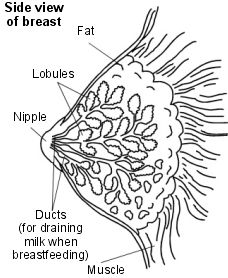
Breast tissue is attached to muscle on the chest wall. A 'tail' of breast tissue extends up into the armpit. Men have a small amount of breast tissue around the nipples. The breasts contain:
Many women find that their breasts become more lumpy and tender before periods. Breasts also alter their size and shape with increasing age, pregnancy, and with marked weight changes. What is important is that you get to know your own breasts - how they look and feel - and report any changes promptly to a doctor.
What is cancer?
Cancer is a disease of the cells in the body. The body is made up from millions of tiny cells. There are many different types of cell in the body, and there are many different types of cancer which arise from different types of cell. What all types of cancer have in common is that the cancer cells are abnormal and multiply 'out of control'.
A malignant tumour is a 'lump' or 'growth' of tissue made up from cancer cells which continue to multiply. Malignant tumours invade into nearby tissues and organs which can cause damage.
Malignant tumours may also spread to other parts of the body. This happens if some cells break off from the first (primary) tumour and are carried in the bloodstream or lymph channels to other parts of the body. These small groups of cells may then multiply to form 'secondary' tumours (metastases) in one or more parts of the body. These secondary tumours may then grow, invade and damage nearby tissues, and spread again.
Some cancers are more serious than others, some are more easily treated than others (particularly if diagnosed at an early stage), some have a better outlook (prognosis) than others.
So, cancer is not just one condition. In each case it is important to know exactly what type of cancer has developed, how large it has become, and whether it has spread. This will enable you to get reliable information on treatment options and outlook.
See separate leaflet called 'What is Cancer' for further details about cancer in general.
What is breast cancer?
Breast cancer is one of the most common cancers in the world. More than 30,000 cases are diagnosed in the UK each year. Most cases develop in women over the age of 50 but younger women are sometimes affected. Breast cancer can also develop in men, although this is rare. Breast cancer develops from a cancerous cell which develops in the lining of a duct or lobule in one of the breasts.
There are some 'sub-types' of breast cancer which are important to know as the treatment and prognosis (outlook) vary depending on the exact type of the cancer. The following gives a rough idea of the main sub-types. Your specialist will be able to give you more details as to the exact sub-type of breast cancer that you have.
Invasive or 'in situ'
Most breast cancers are diagnosed when a tumour has grown from within a duct or lobule into the surrounding breast tissue. These are called 'invasive' breast cancers. Invasive breast cancers are also divided into those where cancer cells have invaded into local blood or lymphatic vessels and those that have not.
Some people are diagnosed when the cancerous cells are still totally within a duct or lobule. These are called 'carcinoma in situ' as no cancer cells have grown out from their original site. A carcinoma in situ is easier to treat and has a better outlook than an invasive cancer.
Grade of the cancerous cells
A sample of breast cancer tissue can be looked at under the microscope. By looking at certain features of the cells the cancer can be 'graded'. As a rough guide, the lower the grade, the better the cancer is likely to respond to treatments such as chemotherapy and radiotherapy.
Hormone responsive or non-hormone responsive
Tests on a sample of breast cancer cells can show if they 'respond' to oestrogen, the main female hormone. Breast cancers are divided into two types:
Stage of the cancer
This does not describe a type of cancer, but describes how much the cancer has grown and whether it has spread (see below). As a general rule, the earlier the stage, the greater the chance of a cure.
What causes breast cancer?
A cancerous tumour starts from one abnormal cell. The exact reason why a cell becomes cancerous is unclear. It is thought that something damages or alters certain genes in the cell. This makes the cell abnormal and multiply 'out of control'. (See separate leaflet called 'What Causes Cancer' for more details.)
Risk factors
Although breast cancer can develop for no apparent reason, there are certain 'risk factors' which increase the chance that breast cancer will develop. These include:
Family history and genetic testing
About 1 in 20 breast cancers are caused by a 'faulty gene' which can be inherited. Breast cancer which is linked to a faulty gene most commonly affects women in their 30s and 40s. If you have a strong family history of breast cancer you may wish to discuss this with your doctor. Genetic testing to see if you have inherited certain 'faulty genes' is possible. Alternatively contact the National Hereditary Breast Cancer Helpline (details at the end of the leaflet).